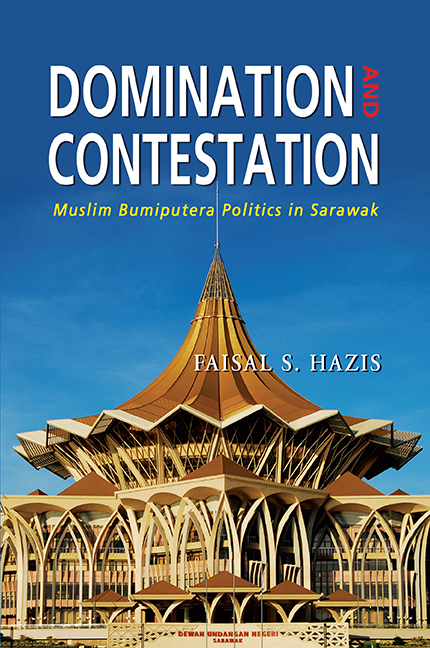Book contents
- Frontmatter
- Contents
- List of Tables
- List of Figures
- Preface
- List of Abbreviations
- 1 Introduction
- 2 State and Social Forces in Sarawak
- 3 The Resurgence of Muslim Bumiputera Politics, 1970–81
- 4 Years of Turbulence, 1981–87
- 5 Consolidation and Domination of the Muslim Bumiputera, 1987–2003
- 6 Muslim Bumiputera Politics in the Post-Mahathir Era, 2003–06
- 7 The Coastal Malays of Southwest Sarawak: A Case Study of the Muslim Bumiputera's Political Domination
- 8 Conclusion
- Postscript
- Appendices
- Bibliography
- Index
- About the Author
2 - State and Social Forces in Sarawak
Published online by Cambridge University Press: 21 October 2015
- Frontmatter
- Contents
- List of Tables
- List of Figures
- Preface
- List of Abbreviations
- 1 Introduction
- 2 State and Social Forces in Sarawak
- 3 The Resurgence of Muslim Bumiputera Politics, 1970–81
- 4 Years of Turbulence, 1981–87
- 5 Consolidation and Domination of the Muslim Bumiputera, 1987–2003
- 6 Muslim Bumiputera Politics in the Post-Mahathir Era, 2003–06
- 7 The Coastal Malays of Southwest Sarawak: A Case Study of the Muslim Bumiputera's Political Domination
- 8 Conclusion
- Postscript
- Appendices
- Bibliography
- Index
- About the Author
Summary
INTRODUCTION
When the Federation of Malaysia was formed in 1963, Sarawak became one of the fourteen negeris that made up the new state. This newly acquired status brought tremendous change to Sarawak politics especially in regards to its autonomy. Although physically isolated from the centre of power in Putrajaya, this isolation fails to deter the central state from imposing its authority in the negeri that is as vast (geographically-speaking) as the Peninsula. Hence, any study of Sarawak politics cannot be done in seclusion from the realm of central state politics. This chapter, therefore, attempts to locate Sarawak within the larger context of Malaysia in order to capture the state-society relation in the negeri. But before that, an analysis of the state formation in Sarawak from the Brunei Sultanate to the establishment of Malaysia will be presented. This analysis provides an understanding of Sarawak politics prior to the formation of Malaysia and the transformation that the former Brunei's territory had undergone since the eighteenth century. The focus of this chapter subsequently shifts to the Malaysian state with a focus on its capability to perform four tasks: penetrate society, extract resources, regulate social relationships, and distribute resources in determined ways. Based on this analysis, we will be able to determine whether Malaysia is a strong or weak state, which is imperative for evaluating its domination of Sarawak politics.
The second part of this chapter examines the role of Sarawak's society in affecting the central state's agenda of dominating the people of the negeri, particularly the Muslim bumiputera. In evaluating the role of Sarawak's society, this chapter identifies several social forces that are influential in mobilizing the populace hence posing a threat to the state. Through the analysis of state and social forces in Sarawak, this chapter provides the basis for an understanding of the role of both entities in establishing political domination among the Muslim bumiputera.
STATE FORMATION IN SARAWAK
The modern negeri of Sarawak as we know today is different from the political entity established more than six centuries ago. As a result of colonialization, the physical boundary of Sarawak had been enlarged from the Sarawak River valley, located at southwest of Borneo, to the Lawas River valley, located at north of Borneo.
- Type
- Chapter
- Information
- Domination and ContestationMuslim Bumiputera Politics in Sarawak, pp. 22 - 70Publisher: ISEAS–Yusof Ishak InstitutePrint publication year: 2011

